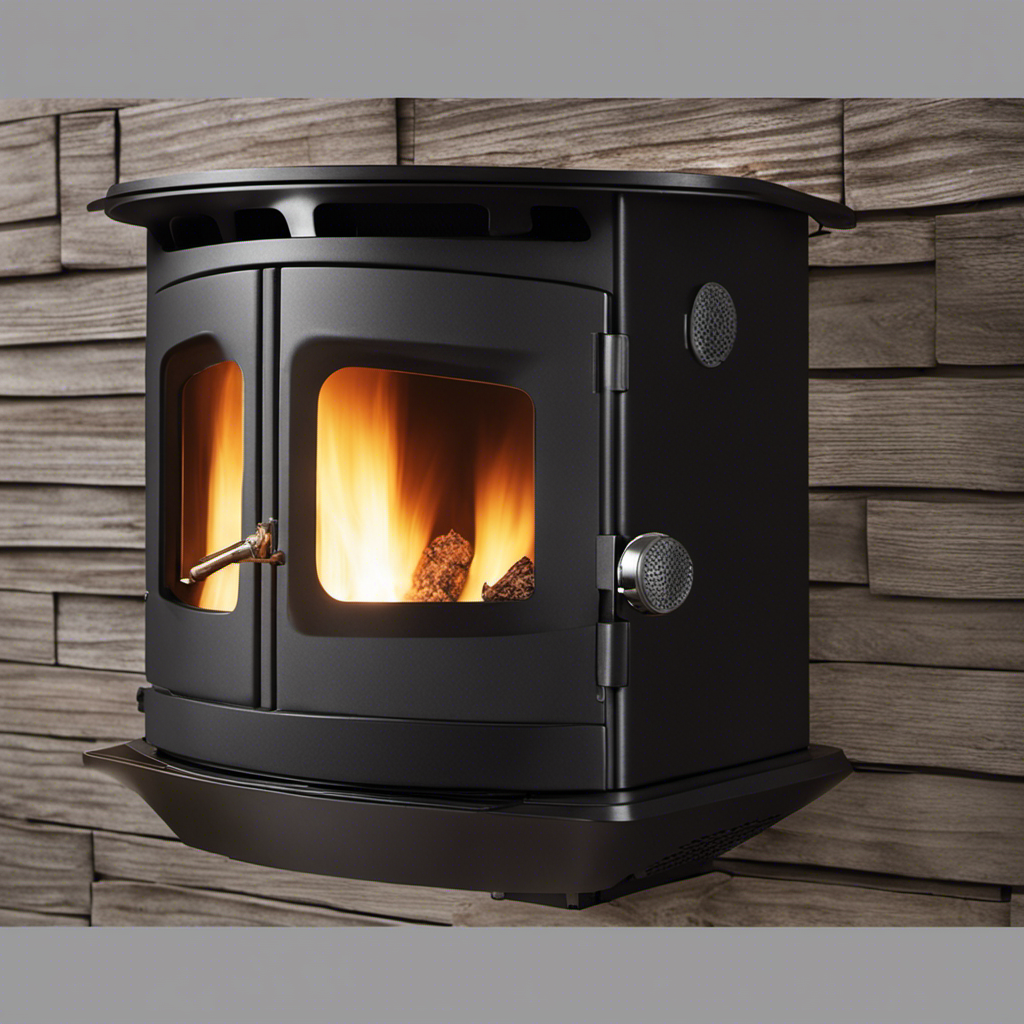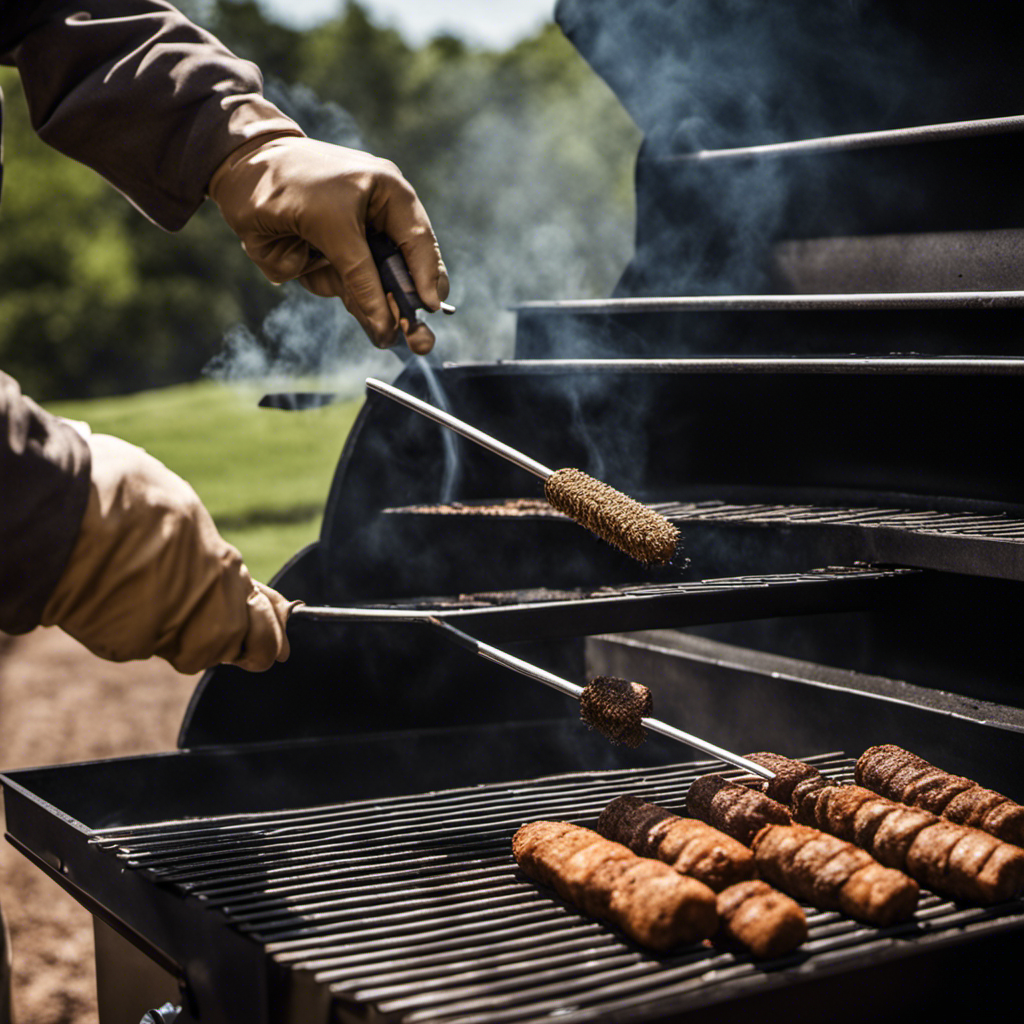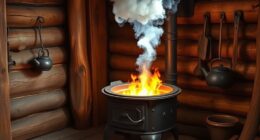I’m extremely thrilled to share my expertise on how to start and use the Pit Boss 700sc Wood Pellet Grill.
Picture this: the aroma of smoky goodness filling the air, the sizzle of perfectly seared meats, and the mouthwatering flavors that only a wood pellet grill can deliver.
In this article, I’ll guide you through getting to know your grill, preparing it for use, and mastering temperature control, all while sharing my tried-and-true cooking tips and techniques.
Let’s fire up that Pit Boss and get grilling!
Key Takeaways
- The Pit Boss 700sc Wood Pellet Grill has a spacious cooking area of 700 square inches and a digital control board for easy temperature control.
- Proper maintenance and cleaning of the grill, including regularly cleaning the grill grates and emptying the ash trap, are essential for optimal performance and longevity.
- Mastering temperature control is crucial for achieving perfect grilling results, and it is important to start with a clean grill and choose the right wood pellets for desired flavor and temperature.
- The Pit Boss 700sc Wood Pellet Grill offers an enhanced grilling experience with features like a grease management system, porcelain-coated grill grates, and the ability to experiment with different pellet flavors for mouthwatering dishes.
Getting to Know Your Pit Boss 700sc Wood Pellet Grill
Before you start cooking on your Pit Boss 700sc wood pellet grill, it’s important to get to know its features and functions.
The Pit Boss 700sc is packed with amazing features that will enhance your grilling experience. It has a spacious cooking area of 700 square inches, allowing you to grill a variety of foods at once. The grill also comes with a digital control board, which allows you to easily set and maintain the desired temperature.
Cleaning and maintenance of the Pit Boss 700sc is a breeze. The grill is equipped with a grease management system that collects and removes excess grease, making cleanup quick and easy. Additionally, the grill grates are porcelain-coated, making them non-stick and easy to clean.
Now that you’re familiar with the features and how to keep your grill clean, let’s move on to preparing your grill for use without any delay.
Preparing Your Grill for Use
To ensure your grill is ready to use, make sure you’ve properly prepared it for cooking on the Pit Boss 700sc wood pellet grill. Cleaning and maintaining your grill is essential for optimal performance and longevity.
Here are some key steps to follow:
-
Clean the grill grates: Use a grill brush to remove any leftover food debris and grease from the grates. This will prevent any unwanted flavors on your next cook.
-
Empty the ash trap: Regularly empty the ash trap to keep the grill running smoothly. Excess ash can hinder the airflow and temperature control.
-
Proper storage: When not in use, cover your grill with a fitted grill cover to protect it from the elements. Store it in a dry and well-ventilated area to prevent rust and damage.
By following these cleaning instructions and proper storage practices, you’ll ensure that your Pit Boss 700sc wood pellet grill is always ready to deliver delicious and flavorful meals.
Now, let’s move on to starting up your grill and getting the fire going.
Starting up Your Pit Boss 700sc Wood Pellet Grill
Once you’ve completed the cleaning and storage steps, you’ll be ready to fire up your Pit Boss 700sc wood pellet grill. Before starting, it’s important to ensure that your grill is in good working condition. Regular grill maintenance is key to avoiding common issues that can arise.
Make sure to check the hopper for any leftover pellets and clean out any ash from the firepot. Additionally, inspect the electrical connections and make sure everything is secure. If you encounter any problems, such as difficulty igniting the grill or inconsistent temperature, troubleshooting common issues can help.
Check the power source, ensure the auger is turning properly, and adjust the temperature settings accordingly. By taking good care of your grill and troubleshooting any issues that arise, you’ll be able to enjoy delicious meals with ease.
Now, let’s move on to mastering temperature control on your grill.
Mastering Temperature Control on Your Grill
Now that you know the importance of regular maintenance, let’s focus on mastering temperature control for optimal grilling on your Pit Boss 700sc wood pellet grill.
Achieving the perfect temperature is crucial for cooking your food to perfection and enhancing its flavor. Here are some key tips to help you master temperature control:
-
Start with a clean grill: Regular grill maintenance ensures that your grill performs at its best and maintains consistent temperatures.
-
Choose the right pellets: The type of wood pellets you use can affect the temperature and flavor of your food. Experiment with different flavors to find your preference.
By understanding the importance of grill maintenance and pellet selection, you are well on your way to becoming a grilling aficionado.
Now, let’s dive into some cooking tips and techniques on the Pit Boss 700sc wood pellet grill, where we will explore the art of creating mouthwatering dishes without missing a beat.
Cooking Tips and Techniques on the Pit Boss 700sc Wood Pellet Grill
When experimenting with different flavors of wood pellets on the Pit Boss 700sc, you’ll discover how they can enhance the taste and temperature of your grilled dishes. Cooking on the Pit Boss 700sc is all about mastering the art of temperature control and understanding the cooking times for different ingredients. The table below outlines some popular wood pellet flavors and their corresponding flavor profiles, helping you choose the perfect one for your next grilling adventure.
| Wood Pellet Flavor | Flavor Profile |
|---|---|
| Apple | Sweet, fruity |
| Hickory | Strong, smoky |
| Mesquite | Bold, intense |
| Cherry | Mild, slightly sweet |
Are the Steps to Start and Cook on a Pit Boss 700sc Wood Pellet Grill the Same as Using a Pit Boss Wood Pellet Grill in General?
Yes, the steps to start and cook on a Pit Boss 700sc Wood Pellet Grill are the same as using a Pit Boss Wood Pellet Grill in general. The process for preheating, adding wood pellets, and adjusting the temperature is identical when using Pit Boss grill models.
Frequently Asked Questions
Can I Use the Pit Boss 700sc Wood Pellet Grill for Smoking Meats?
Yes, the Pit Boss 700sc wood pellet grill is perfect for smoking meats. With its precise temperature control, you can achieve delicious smoky flavors and tender, juicy results every time.
How Do I Clean the Grates on the Pit Boss 700sc Wood Pellet Grill?
To clean the grates on the Pit Boss 700sc Wood Pellet Grill, simply brush off any excess debris and preheat the grill on high. Then, use a grill brush to scrub the grates clean. Regular maintenance is key to keeping your grill in top shape.
Can I Use Different Types of Wood Pellets in the Grill?
Yes, you can use different types of wood pellets in the grill. Each flavor adds a unique taste to your food. Advantages include versatility and the ability to experiment with flavors. Disadvantages may be cost and availability.
How Long Does It Take for the Grill to Reach the Desired Temperature?
It feels like an eternity, but the Pit Boss 700sc Wood Pellet Grill will reach the desired temperature in just a matter of minutes. Patience is key, my friends, for the perfect cook awaits.
Can I Use the Grill in Cold Weather Conditions?
Yes, you can use the grill in cold weather conditions. Here are some tips for winter grilling: preheat the grill for longer, use a grill cover, and consider using a thermal blanket to retain heat.
Conclusion
Well, there you have it, folks. The ins and outs of starting up and cooking on the Pit Boss 700sc Wood Pellet Grill.
Now that you’re armed with all this knowledge, you’ll be grilling like a pro in no time.
Who needs fancy restaurants when you can create culinary masterpieces right in your own backyard?
So fire up that grill, embrace the smoky aroma, and let your taste buds be amazed.
Trust me, your friends and family will be begging for seconds (and thirds!).
Happy grilling, my fellow pit masters!
Growing up surrounded by the vast beauty of nature, Sierra was always drawn to the call of the wild. While others sought the comfort of the familiar, she ventured out, embracing the unpredictable and finding stories in the heartbeat of nature.
At the epicenter of every remarkable venture lies a dynamic team—a fusion of diverse talents, visions, and passions. The essence of Best Small Wood Stoves is crafted and refined by such a trio: Sierra, Logan, and Terra. Their collective expertise has transformed the platform into a leading authority on small wood stoves, radiating warmth and knowledge in equal measure.











